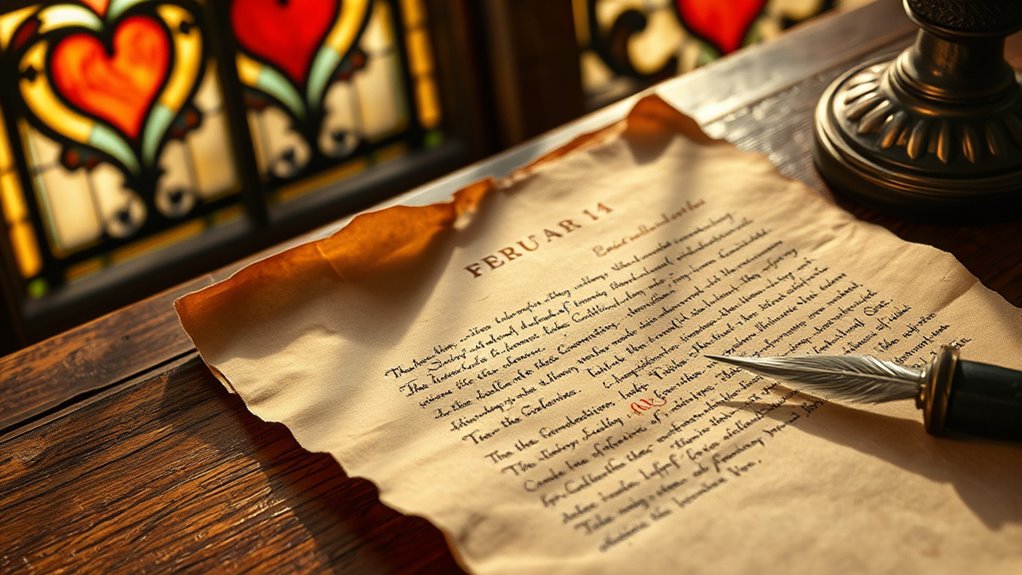February 14 is historically significant because it links to ancient Roman festivals like Lupercalia, a fertility celebration involving pairing couples, which later influenced Valentine’s Day traditions. The date also commemorates Saint Valentine, a Christian martyr who defied authorities to marry couples secretly. Over time, the holiday shifted from pagan and religious roots to a day symbolizing love and devotion. If you want to explore how these traditions evolved, there’s more to uncover.
Key Takeaways
- February 14 is linked to the ancient Roman festival of Lupercalia, a fertility celebration held in mid-February.
- The date was later associated with Saint Valentine, a Christian martyr who promoted love and marriage.
- Medieval Europeans connected February 14 with the idea of courtly love, enhancing its romantic significance.
- The day evolved from pagan and religious traditions into a celebration of romantic devotion over centuries.
- Commercialization in the 19th century popularized mass-produced cards, cementing February 14 as a global day for love.

Have you ever wondered why February 14th is celebrated as a day of love? The answer lies in the fascinating history of Valentine’s Day origins and its deep historical significance. This date wasn’t chosen at random; it’s rooted in centuries of tradition, myth, and religious observance that have evolved over time. Understanding the roots of this holiday helps explain why it continues to be a prominent celebration of affection and romance today.
The origins of Valentine’s Day date back to ancient Rome, where it was associated with the festival of Lupercalia, a fertility celebration held in mid-February. During this festival, young men and women would pair off, often through a lottery system, to promote love and fertility. Over time, as Christianity spread across the Roman Empire, many pagan festivals, including Lupercalia, were replaced or absorbed into Christian observances. By the 5th century, the church sought to Christianize the celebration, linking it to the feast day of Saint Valentine. There were multiple saints named Valentine, but the most popular story involves a priest named Valentine who defied Emperor Claudius II’s ban on marriages for young men, secretly marrying couples and performing their ceremonies. This act of defiance turned Valentine into a martyr, symbolizing love and sacrifice, which helped cement his association with romantic love.
The historical significance of Valentine’s Day grew through the centuries. In medieval Europe, it became linked to the notion of courtly love, with poets and writers romanticizing the holiday. By the 18th and 19th centuries, exchanging handwritten notes and gifts became popular, setting the foundation for modern Valentine’s Day traditions. Additionally, the tradition of exchanging tokens of affection was reinforced by the popularity of handmade cards, which helped personalize expressions of love. The day adopted a more commercial aspect as it spread globally, especially with the rise of mass-produced cards in the 19th century. Today, February 14th is seen not only as a celebration of romantic love but also as a day to express appreciation for friends and family.
Frequently Asked Questions
How Did February 14 Become Associated With Love and Romance?
You might not realize it, but February 14 became associated with love and romance because of romantic traditions rooted in historical connections. Over centuries, people celebrated Saint Valentine, a symbol of affection, which helped shape the holiday’s romantic significance. As these stories spread, couples started exchanging love notes and gifts, cementing February 14 as a day to express affection. Today, those romantic traditions continue, making the date a global celebration of love.
Are There Other Historical Events Linked to February 14?
You might think of February 14 as a day woven with romantic legends, but it’s also tied to historical conflicts. For instance, it marks the feast day of Saint Valentine, whose story blends love and martyrdom. Additionally, the date has seen significant events like the signing of treaties and battles, making it a tapestry of love and history. So, this day isn’t just about romance—it’s a reflection of historical struggles and legends.
Did Valentine’s Day Have Different Origins in Various Cultures?
Yes, Valentine’s Day has different origins in various cultures. You might find that some cultural traditions blend religious festivals with romantic celebrations, like how in Italy, Lupercalia was a fertility festival, or in Japan, women give chocolates for love. These diverse roots reflect how the date’s significance varies worldwide, combining religious, historical, and cultural influences that shape Valentine’s Day into a uniquely global celebration of love.
Why Is February 14 Linked to Saint Valentine Specifically?
You might think February 14 is just a random date, but it’s linked to Saint Valentine through romantic legends and saint stories. Legend has it that Saint Valentine secretly married couples to help soldiers, defying Roman rules. His story, combined with these tales, cemented February 14 as a day to celebrate love. Over time, his name became associated with romantic gestures, making it a special day for lovers worldwide.
How Has the Celebration of February 14 Evolved Over Centuries?
Over centuries, you see how the celebration of February 14 has evolved from simple romantic customs to widespread traditions. Initially, it was a day honoring Saint Valentine’s historical evolution as a symbol of love and devotion. Now, you participate in exchanging cards, flowers, and gifts, reflecting changing societal views on romance. This shift highlights how cultural practices adapt while maintaining their core focus on love and affection.
Conclusion
So, next time February 14 arrives, remember there’s more to it than just chocolates and roses. Beneath the surface, a story of mystery, tradition, and history unfolds, leaving you wondering what secrets this date might still hold. Could there be something more hidden in its origins? Perhaps the answer is closer than you think. Keep your curiosity alive—because sometimes, the most surprising truths are just waiting to be discovered.









